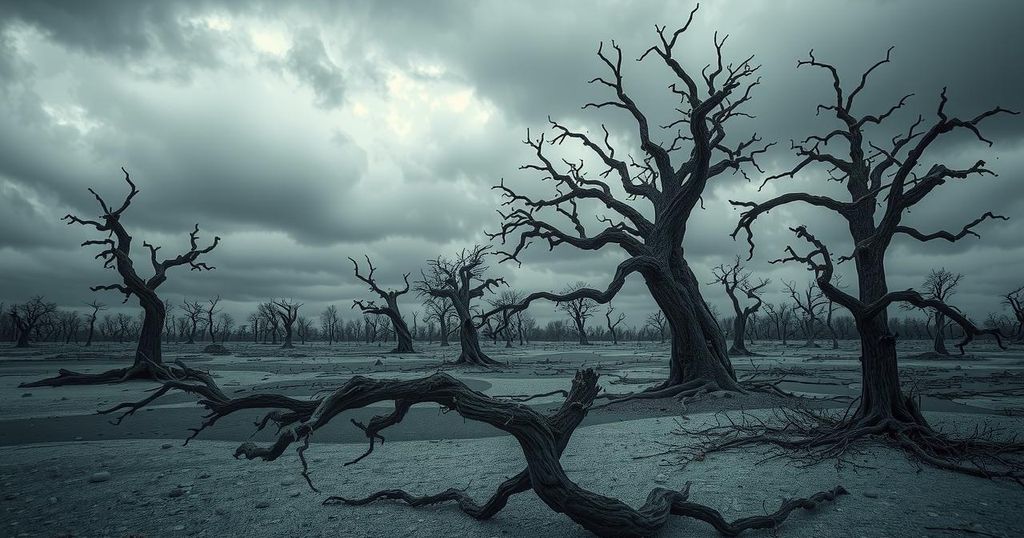Climate change
AFRICA, BELLSTEDT, CLIMATE CHANGE, CONSERVATION, DIRK BELLSTEDT, EAST - AFRICAN RIVER VALLEY SYSTEM, ECOLOGY, ENVIRONMENT, ENVIRONMENTAL PROTECTION, FAMILY LEGACY, GONGONI FOREST, KENYA, MUSEUM FOR CENTRAL AFRICA, ROYAL, STELLENBOSCH UNIVERSITY, SU, VOLKSWAGEN FOUNDATION, ZOOTAXA
Leila Ramsay
0 Comments
Discovery of a New Critically Endangered Killifish Species in Kenya
A new species of critically endangered killifish, *Nothobranchius sylvaticus*, has been identified in the Gongoni Forest of Kenya. This is the first endemic killifish known to inhabit a forest. The species was confirmed through DNA analysis and phylogenetic studies, indicating a divergence of approximately 7.09 million years. Conservation risks due to its limited habitat are noted, emphasizing the need for further preservation efforts.
A newly identified species of killifish, named Nothobranchius sylvaticus, has been reported as critically endangered in a recent publication in the journal Zootaxa. This species, which derives its name from the Latin for “pertaining to the forest,” is notable as the first endemic killifish to thrive in a forest habitat. It was discovered during research expeditions conducted in the Gongoni Forest of southeastern coastal Kenya in 2017 and 2018.
Led by Professor Dirk Bellstedt, emeritus professor of biochemistry at Stellenbosch University, the research team sampled fish from ephemeral swamps as part of an “Off the Beaten Track” research initiative supported by the Volkswagen Foundation in Germany. The team utilized a combination of principal component analysis on the fish’s physical attributes and DNA sequencing to establish that N. sylvaticus represents a new species. The most comprehensive phylogenetic analysis for the genus revealed that this lineage diverged from its closest relative approximately 7.09 million years ago.
Professor Bellstedt highlighted that this divergence indicates the Gongoni Forest is at least 7.09 million years old. Covering approximately 8.2 square kilometers, the forest exemplifies the East African Mosaic, characterized by savannah interspersed with forested areas, stretching from Pondoland in South Africa to southern coastal Somalia.
Since 2015, the research team has integrated next-generation DNA sequencing with advanced rock dating techniques aimed at reconstructing the geological history of central Africa over the past 20 million years. This region has experienced significant tectonic shifts and landform breakups in the last five to thirty million years.
The discovery of N. sylvaticus adds to the understanding of the evolutionary changes in the genus Nothobranchius coinciding with paleodrainage dynamics influenced by tectonic activities that shaped the East African River Valley System. However, the species faces critical conservation threats due to its limited habitat in the ancient forest. Specimens of the fish have been preserved at the National Museums of Kenya in Nairobi, and comparative specimens are housed at the Royal Museum for Central Africa in Tervuren, Belgium.
The paper titled, “The description of a critically endangered new species of seasonal killifish, Nothobranchius sylvaticus (Cyprinodontiformes: Nothobranchiidae), a relict species from an East African forest refugium in southeastern Kenya,” features contributions from several authors, including Professor Bellstedt and Dr. P. de Wet van der Merwe, among others.
The identification of *Nothobranchius sylvaticus* as a critically endangered species highlights the ecological significance and conservation challenges faced by the Gongoni Forest. With the forest’s rich geological history now further corroborated by scientific evidence, ongoing preservation efforts will be crucial to ensure the survival of this unique killifish and its habitat.
Original Source: www.sun.ac.za




Post Comment